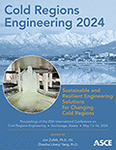Conceptual Design of Quantitative Risk Algorithms for a Geohazard and Geo-Asset Management System for Roadway Networks in Permafrost Regions
Publication: Cold Regions Engineering 2024: Sustainable and Resilient Engineering Solutions for Changing Cold Regions
ABSTRACT
Within the Northwest Territories, Canada, permafrost is ubiquitous with communities and industrial development requiring transportation infrastructure (e.g., roadways, airports, and railways) or other linear infrastructure (e.g., pipelines and transmission lines) to accommodate potentially unstable subgrades. In these regions, transportation is of vital social, economic, and political importance. However, warming climate conditions are and will impact the integrity of existing and future transportation infrastructure constructed in permafrost regions. Existing analytical frameworks and tools for geohazard and geo-asset management have not included hazards derived from permafrost; where the ubiquity of permafrost results in the hazard being nearly ever-present underlying the infrastructure and ever changing as climate warming continues through time. This paper presents the conceptual design of quantitative risk algorithms for a geohazard assessment system using dynamic segmentation techniques to discretize the infrastructure spatially based on credibility factors for individual dangers specific to permafrost and changing thermal conditions. The hazard (probability of occurrence) will be calculated based on current conditions and projected using IPCC climate projects for the infrastructure region. This discretized approach will allow infrastructure owners to determine current high-risk areas as well as projections for high-risk areas in the future allowing for more efficient infrastructure improvement planning and an overall increase in roadway network safety.
Get full access to this chapter
View all available purchase options and get full access to this chapter.
REFERENCES
Baecher, G.B., and J.T. Christian (2003). Reliability and Statistics in Geotechnical Engineering. Chichester, West Sussex, England: John Wiley and Sons, Ltd.
Brooks, H. (2019). Quantitative Risk Analysis for Linear Infrastructure Supported by Permafrost: Methodology and Computer Program. Doctoral Thesis, Laval University, Quebec City, QC.
Doré, G., F. Niu, and H. Brooks. 2016. “Adaptation Methods for Transportation Infrastructure Built on Degrading Permafrost.” Permafrost and Periglacial Processes, IPA Transactions, Published Online.
Haeberli, W., and C. Whiteman (2015). “Snow and Ice-Related Hazards, Risks and Disasters: A General Framework.” In Snow and Ice-Related Hazards, Risks and Disasters, edited by W. Haeberli, C. Whiteman, and J.F. Shroder, Chapter 1:1–34. Waltham, MA, USA: Elsevier.
Heginbottom, J.A., Dubreuil, M.A., and Harker, P.T. (1995). Permafrost Map of Canada. The National Atlas of Canada; Natural Resources Canada. DOI/10.4095/294672.
Lacasse, S., and Nadim, F. (2011). “Learning to Live with Geo-Hazards: From Research to Practice.” In Geotechnical Risk Assessment and Management, edited by C.H. Juang, K.K. Phoon, A.J. Puppala, R.A. Green, and G.A. Fenton, GSP 224:64–116. Atlanta, Georgia, USA: ASCE, New York, New York, USA.
Lewkowicz A., Boehlert, B, Helman, J., Chinowski, P., Rennels, L. and Clar, D. (2020). Estimating the cost of climate change-induced permafrost thaw on Canadian infrastructure. In Proceedings of the Virtual Annual General Meeting of the Canadian Permafrost Association, November 16 & 17, 2020, 19.
O’Neil, H.B., Wolfe, S.A., and Duchesne, C. (2020). Ground Ice Map of Canada. Geological Survey of Canada, Open File 8713. DOI:.
Regehr, J.D., Milligan, C.A., and Alfaro, M. (2013) “Review of the Effectiveness and Costs of Strategies to Improve Stability in Permafrost Regions.” Journal of Cold Regions Engineering; 27 (3): 109–131. p
Stockton, E.J., Burn, C.R., and Humphries, J. (eds.) 2021. Transport Canada’s Northern Transportation Adaptation Initiative (NTAI) 2011-2021. Carleton University, Ottawa, ON.
Uddin, N., and A.H.-S. Ang (2011). “Quantitative Risk Assessment (QRA) for Natural Hazards.” Monograph 5. ASCE Council on Disaster Risk Management. Reston, Virginia, USA: ASCE.
Vita, C.L. (1983a). “A Geotechnical Engineering Systems Approach for Arctic Transportation Facility Planning and Design.” Civil Engineering Systems 1 (2): 58–62.
Vita, C.L. (1983b). “The Systematic Use of Geotechnical Data for Characterization of Transportation Routes.” Civil Engineering Systems 1: 23–32.
Information & Authors
Information
Published In
History
Published online: May 9, 2024
ASCE Technical Topics:
Authors
Metrics & Citations
Metrics
Citations
Download citation
If you have the appropriate software installed, you can download article citation data to the citation manager of your choice. Simply select your manager software from the list below and click Download.
